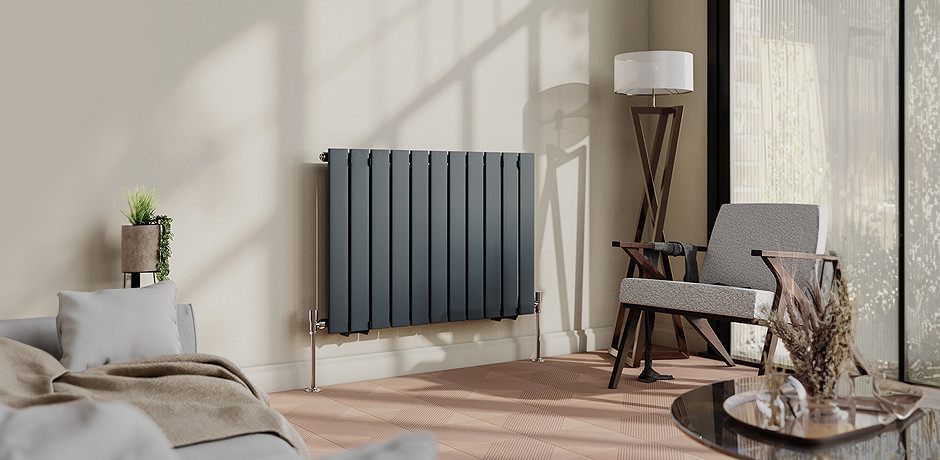OUR WINTER SALE ENDS SOON!
*Boxing Day deals coming soon. Free delivery on orders over £499
My Radiator is Cold at Bottom Hot at Top
My Radiator is Cold at Bottom Hot at Top
Many people experience problems with their radiators after summer due to inactivity. So, if your radiator feels cold at the bottom and hot at the top, here’s why and what to do!

If you’re worried that your radiator isn’t working properly because it feels cold at the bottom and hot at the top, don’t panic! Most people encounter multiple radiator-related issues during their lifetime, and most can be fixed fairly easily. One of the main problems people have with their radiator is when it feels cold at the bottom and hot at the top. This can be an issue, particularly during winter; a time when people want to maximise the heat in their house for warmth. If you want to be prepared for this issue, have a read of this blog, as we try to give you the ins and outs of why, and how to fix, your radiator when it’s cold at the bottom and hot at the top!
How do radiators operate?
Radiators rely on the use of convection, a process that involves moving heat through fluid. The fluid in your radiator will depend on what type of radiator you have. For example, a radiator that runs on central heating will have water in the pipes that run through the radiator. This means that heat is transferred by hot water travelling to different parts of the radiator. On the other hand, the fluid in an electric radiator is usually oil or glycol, a thermodynamic fluid designed to retain heat. It is important to consider what kind of radiator you have before you attempt to play around with its mechanisms. Electric radiators don’t have moving parts in the same way that central heating does, therefore will most likely never need bleeding or flushing.

Why is my radiator cold at the bottom and hot at the top?
If you are noticing that the bottom of your central heating radiator is refusing to heat up properly, it is most likely because there is a blockage in the radiator’s pipes. After some time, debris and a build-up of dirt and rust can accumulate inside the bottom of your radiator, causing the flow of hot water to be restricted. If this is the case, here are a few tips to solve the problem:
What to do if my radiator is cold at the bottom and hot at the top?
1) Turn off your central heating or, if you have a thermostatic radiator valve, switch it down to zero. There will also be another valve called a lock shield valve, which is located at the other end of your radiator as the thermostatic radiator valve. Using a spanner, close the valve. As this process will involve water exiting your radiator, you want to make sure that it isn’t still hot.
2) Get ready for a leakage! Put a towel down around your radiator and grab some big bowls first as your radiator will leak lots of water when you bleed the valve.
3) Bleed your radiator. This will involve opening the bleed valve located near the top of your radiator. Expect a lot of water to flow out as you let in the air.
4) Disconnect and clean. Once all of the water has flushed out, disconnect the radiator from the valves and take it outside so to properly clean out the pipes. Do this with a hose; only when the water runs clear is it completely clean.
5) Reattach your radiator. Finally, put your radiator back, reattach the pipes and turn your valves the opposite way that you did earlier (back to what it was before). As soon as you’re done this, close the bleed valve as quickly as possible, as your radiator will immediately start filling up with water again!

What to do if the problem persists?
If you’ve completed the steps above, but the same problem persists, make sure you check that:
1) the thermostat valve is not stuck and is working properly
2) the central heating pump is circulating water properly
If the problem continues, it may be best to call in a professional heating engineer as it may be a bigger issue with your heating system.
Can I prevent this from happening again?
Sometimes, issues that you may face with your radiator are unavoidable, however, there are small things that you can do to decrease the frequency of these problems. You can try to prevent the build-up of sediment in your radiator by installing an inhibitor. An inhibitor is a chemical designed to prevent corrosion in your radiator, improving your radiator’s overall efficiency in transporting heat. Inhibitors aren’t too pricey and are fairly simple to add to your heating system.

Hannah
Hannah is one of our bathroom bloggers here at Victorian Plumbing. She'll be posting updates on the latest bathroom trends and decorating tips. Look out for her expert 'how to' step-by-step DIY guides too!


